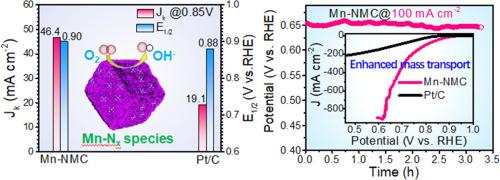氮掺杂碳中空间限制原子锰用于锌空气电池的氧还原
IF 5.6
3区 材料科学
Q1 ELECTROCHEMISTRY
引用次数: 0
摘要
非贵重的锰基催化剂已成为锌空气电池非常理想的氧还原反应(ORR)电催化剂,因为它们具有与铁基催化剂相当的活性,同时通过避免芬顿诱导的降解表现出优异的稳定性。本文报道了一种具有原子分散Mn- nx位的n掺杂介孔碳催化剂(Mn-NMC),其多孔NMC结构(BET表面积:2161.6 m2 g−1)的空间约束效应能够有效地稳定和接近单个Mn原子。因此,Mn-NMC催化剂通过原子分散的Mn-Nx活性位点增强内在活性和多孔NMC基质优化活性位点的可及性和质量传递的协同组合,实现了优异的ORR活性和耐久性。与RHE相比,它提供了0.90 V的半波电位,0.85 V时的动态电流密度为46.4 mA cm - 2,连续工作6小时后电流保持率为96%,明显优于传统的基于nc的同类产品。在实际应用中,基于mn - nmc的阴极使锌空气电池能够达到178/400 mW cm - 2(水性/柔性)的峰值功率密度,良好的速率能力可保持高达50/40 mA cm - 2的稳定运行,以及令人满意的循环稳定性为~ 1100/85小时。此外,mn - nmc基水锌空气电池可以在-4°C下良好地工作,峰值功率密度为116 mW cm - 2,在10 mA cm - 2下稳定工作260小时以上。这些结果突出了Mn-NMC作为下一代能源技术中贵金属催化剂的可持续替代品的结构优势。本文章由计算机程序翻译,如有差异,请以英文原文为准。


Spatially confined atomic manganese in N-doped carbon for oxygen reduction in Zn-air batteries
Non-precious Mn-based catalysts have emerged as highly desirable oxygen reduction reaction (ORR) electrocatalysts for Zn-air batteries, as they possess comparable activity to Fe-based catalysts while exhibiting superior stability by avoiding Fenton-induced degradation. Herein, we report an N-doped mesoporous carbon catalyst with atomically dispersed Mn-Nx sites (Mn-NMC), where the spatial confinement effect of its porous NMC architecture (BET surface area: 2161.6 m2 g−1) enables effective stabilization and accessibility of single Mn atoms. Therefore, Mn-NMC catalyst achieves exceptional ORR activity and durability through synergistic combination of atomically dispersed Mn-Nx active sites in enhancing intrinsic activity and the porous NMC matrix in optimizing active sites accessibility and mass transport. It delivers a half-wave potential of 0.90 V vs. RHE, a kinetic current density of 46.4 mA cm−2 at 0.85 V, and 96 % current retention after 6 h of continuous operation, significantly outperforming its conventional NC-based counterparts. In practical applications, the Mn-NMC-based cathodes enable Zn-air batteries to achieve high peak power densities of 178/400 mW cm−2 (aqueous/flexible), favorable rate capability maintaining stable operation up to 50/40 mA cm−2, along with satisfactory cycling stability for ∼ 1100/85 h. Apart from that, Mn-NMC-based aqueous Zn-air battery can operate well at -4 °C, delivering a peak power density of 116 mW cm−2 and maintaining stable operation for over 260 h at 10 mA cm−2. These results highlight the structural advantages of Mn-NMC as a sustainable alternative to precious-metal catalysts for next-generation energy technologies.
求助全文
通过发布文献求助,成功后即可免费获取论文全文。
去求助
来源期刊

Electrochimica Acta
工程技术-电化学
CiteScore
11.30
自引率
6.10%
发文量
1634
审稿时长
41 days
期刊介绍:
Electrochimica Acta is an international journal. It is intended for the publication of both original work and reviews in the field of electrochemistry. Electrochemistry should be interpreted to mean any of the research fields covered by the Divisions of the International Society of Electrochemistry listed below, as well as emerging scientific domains covered by ISE New Topics Committee.
 求助内容:
求助内容: 应助结果提醒方式:
应助结果提醒方式:


